I've been reading all about chip amps for the past while, and encountered something I'd never heard of before, but is very familiar around here - composite amplifiers.
I'd be curious to hear the pros and cons, from some users particularly regarding subjective sound quality.
What I see when I look at a composite amplifier, is a small signal op-amp cascaded with a power op-amp. The open loop gain of the cascaded amplifiers has got to be absolutely astronomical, and it allows a huge amount of negative feedback to be applied, resulting in extremely high damping factor and very low harmonic distortion. The huge amount of feedback is clearly hard to tame, because every design I've seen has a low pass and/or low frequency shelf filter added in between the two stages, as well as numerous other compensation components, and is also very critical regarding layout.
My worry about this design, is that usually so much feedback has a cost. Aside from the obvious design difficulty of keeping things stable, I wonder how it subjectively compares to the data sheet implementation when driving expensive speakers. From my experience building tube amps, feedback improves things up to a point, but then after that point starts to make things worse. I wonder if there is a similar subjective effect here, or not?
Have there every been any commercially made composite amplifiers which attained a good reputation?
I'd be curious to hear the pros and cons, from some users particularly regarding subjective sound quality.
What I see when I look at a composite amplifier, is a small signal op-amp cascaded with a power op-amp. The open loop gain of the cascaded amplifiers has got to be absolutely astronomical, and it allows a huge amount of negative feedback to be applied, resulting in extremely high damping factor and very low harmonic distortion. The huge amount of feedback is clearly hard to tame, because every design I've seen has a low pass and/or low frequency shelf filter added in between the two stages, as well as numerous other compensation components, and is also very critical regarding layout.
My worry about this design, is that usually so much feedback has a cost. Aside from the obvious design difficulty of keeping things stable, I wonder how it subjectively compares to the data sheet implementation when driving expensive speakers. From my experience building tube amps, feedback improves things up to a point, but then after that point starts to make things worse. I wonder if there is a similar subjective effect here, or not?
Have there every been any commercially made composite amplifiers which attained a good reputation?
I've been reading all about chip amps for the past while, and encountered something I'd never heard of before, but is very familiar around here - composite amplifiers.
I'd be curious to hear the pros and cons, from some users particularly regarding subjective sound quality.
What I see when I look at a composite amplifier, is a small signal op-amp cascaded with a power op-amp. The open loop gain of the cascaded amplifiers has got to be absolutely astronomical, and it allows a huge amount of negative feedback to be applied, resulting in extremely high damping factor and very low harmonic distortion. The huge amount of feedback is clearly hard to tame, because every design I've seen has a low pass and/or low frequency shelf filter added in between the two stages, as well as numerous other compensation components, and is also very critical regarding layout.
My worry about this design, is that usually so much feedback has a cost. Aside from the obvious design difficulty of keeping things stable, I wonder how it subjectively compares to the data sheet implementation when driving expensive speakers. From my experience building tube amps, feedback improves things up to a point, but then after that point starts to make things worse. I wonder if there is a similar subjective effect here, or not?
Have there every been any commercially made composite amplifiers which attained a good reputation?
They are both called "composite amplifiers" and "hybrid amplifiers".
Huge amount of open-loop gain and corresponding much feedback should indeed leave the risk of IMD, as investigated by a Finnish professor.
Have there every been any commercially made composite amplifiers which attained a good reputation?
The Neurochrome "Modulus" power amplifiers are based on that concept. OK?
The open loop gain of the cascaded amplifiers has got to be absolutely astronomical,...............
At least for the composite amplifier we try to design with LM1875, the gain of the LM1875 is reduced seriously by a local LM1875 feedback loop. The LM1875 gain is likely to be in the order of 2-5, soon to be decided and dependent on the OP-AMP used.
Last edited:
They are both called "composite amplifiers" and "hybrid amplifiers".
Huge amount of open-loop gain and corresponding much feedback should indeed leave the risk of IMD, as investigated by a Finnish professor.
Have there every been any commercially made composite amplifiers which attained a good reputation?
The Neurochrome "Modulus" power amplifiers are based on that concept. OK?
The open loop gain of the cascaded amplifiers has got to be absolutely astronomical,...............
At least for the composite amplifier we try to design with LM1875, the gain of the LM1875 is reduced seriously by a local LM1875 feedback loop. The LM1875 gain is likely to be in the order of 2-5, soon to be decided and dependent on the OP-AMP used.
Those Neurochrome amps are what caught my eyes to begin with, and they really do look well engineered. When I say commercially made, I mean more like a finished product though, rather than modules.
I'm going to read through your LM1875 thread, it is really an interesting topic.
Read through Mauro Penasa's thread as well as he started the concept of composite chip amps here. Lots of enthusiastic users.
From what i recall unlike plain chip amps these amps needed a power on delay to avoid the thump. And stability in some loads was questionable.
From what i recall unlike plain chip amps these amps needed a power on delay to avoid the thump. And stability in some loads was questionable.
Read through Mauro Penasa's thread as well as he started the concept of composite chip amps here. Lots of enthusiastic users.
From what i recall unlike plain chip amps these amps needed a power on delay to avoid the thump. And stability in some loads was questionable.
Will do! On the surface it seems like an almost too good to be true path to very low cost high fidelity, it merits more reading.
I'm especially interested in hearing what people say about the sound, as well as the technical side.
Will do! On the surface it seems like an almost too good to be true path to very low cost high fidelity, it merits more reading.
I'm especially interested in hearing what people say about the sound, as well as the technical side.
There could be another reason for not many commercial composite amplifiers being around.
From around the change of millennium, class D amplifiers have been the new "it". But, composite amplifier structures are little useful with class D because of the pronounced phase-turn in the output filter leaving little bandwidth for an external regulation loop. Also the super-sonic but high level of ripple (from the carrier frequency) at a class D output will be difficult to handle in an external loop. Attempts of reducing such ripple further will just leave further phase-turn etc. Thus, a composite amplifier structure is mainly for class AB power stages.
From what I have seen on this forum, a discrete amplifier can without big efforts be designed to do a THD of 0.001% (1W/8Ohm).
Chip-amps themselves will do 0.1-0.01% THD. Hybrid (IC+discrete) solutions like uPC1342V and LM49860 perform in the range 0.005%-0.00005%, and a well build composite amplifier below 0.0001% THD. Thus, for class AB there is a variety of low THD solutions.
Seen from a manufacturer point of view, more than 90% of the customers will not notice the difference between 0.1% or better so if not class D, use a simple chip-amp for this market segment. For the low-THD market, you could use a composite amplifier structure but both competitors and customers would soon know how little there is inside - better use a unique discrete design that is more cumbersome to copy and you can state has an exceptional sound. Alternatively, use the IC+discrete solution but again the customers will think of an ordinary application-sheet implementation. Seen in this light, the composite amplifier is not without competition.
Ultra low THD composite amplifiers require ultra low THD OP-AMPs. Such OP-AMPs were available at reasonable prices some 10 years ago. Thus, too late for the dominating class AB days. So for more reasons, the composite amplifiers are not so commercially attractive as we may think.
Last, while few can clearly hear a difference below a THD of 0.1%, very few (even audiophiles) can clearly hear a difference below 0.01% THD (differences are then not mainly due to lower THD). Thus, a well designed composite amplifier is an amplifier with very low THD but perhaps not an amplifier with the undisputedly best sound. For you to draw the conclusion yourself.
Last edited:
Have there every been any commercially made composite amplifiers which attained a good reputation?
Arcam FMJ A19 to me looks like a composite from the schematic (no values included in the pic). Comes up well in reviews and IIRC got amp of the year 2 years running at What HiFi. I still use one here.
I'd say the newer Arcam SA10 would use a similar circuit I imagine.
Attachments
No, it's not. It's more similar to the simplified version of the super gainclone published by Cordell. C221/R212 are just there for DC feedback and offset control, the opamp doesn't correct the audio frequencies.
And I thought the meaning was to have a tube based amplification stage preceding the chip power amp...
I've read what the op-amp does is provide some gain that the subsequent power amp doesnt have to. Better to have your fixed gains where you want them using local feedback than running multiple cascaded gain stages with a single global feedback.
This works with all tube designs also. Apparently, some of the best sounding tube amps do this. I think it's called "Schade feedback" which puts a local feedback loop around the tube gain stage, rather than count on global feedback around the whole amp circuit...
I just read here on DIYA an article by Pano explaining gain structure in detail. You can find that here: What is Gain Structure?
I've read what the op-amp does is provide some gain that the subsequent power amp doesnt have to. Better to have your fixed gains where you want them using local feedback than running multiple cascaded gain stages with a single global feedback.
This works with all tube designs also. Apparently, some of the best sounding tube amps do this. I think it's called "Schade feedback" which puts a local feedback loop around the tube gain stage, rather than count on global feedback around the whole amp circuit...
I just read here on DIYA an article by Pano explaining gain structure in detail. You can find that here: What is Gain Structure?
That Arcam used an LM3886 in a well reviewed amplifier is great news, and the fact it is not used in the usual data sheet topology is even better.
I remember looking into building a chip amp 20 years ago, and the IC choices were more or less the same as they are now. Given the progress since then with small signal op-amps, it seems to be like a modern class AB power amplifier IC would be capable of new levels of performance!
Too bad the Modulus-86 doesn't come with schematics, it really does seem like the best option performance and engineering wise, but I am thinking a DIY kit without schematics is kind of a show stopper, since it transforms the DIY experience from superficial learning about circuit design to simple assembly of a black box.
I remember looking into building a chip amp 20 years ago, and the IC choices were more or less the same as they are now. Given the progress since then with small signal op-amps, it seems to be like a modern class AB power amplifier IC would be capable of new levels of performance!
Too bad the Modulus-86 doesn't come with schematics, it really does seem like the best option performance and engineering wise, but I am thinking a DIY kit without schematics is kind of a show stopper, since it transforms the DIY experience from superficial learning about circuit design to simple assembly of a black box.
I thought the Mod 86 came with schematics when you actually bought it? The documentation for my Parallel 86 did.
Huge amount of open-loop gain and corresponding much feedback should indeed leave the risk of IMD, as investigated by a Finnish professor.
I suggest you both reading excellent article "The F-word" by Bruno Putzeys. https://linearaudio.net/sites/linearaudio.net/files/volume1bp.pdfMy worry about this design, is that usually so much feedback has a cost. Aside from the obvious design difficulty of keeping things stable, I wonder how it subjectively compares to the data sheet implementation when driving expensive speakers. From my experience building tube amps, feedback improves things up to a point, but then after that point starts to make things worse. I wonder if there is a similar subjective effect here, or not?
He mentions about Otala's work and most important sentence
"The story of re-entrant distortion has an unambiguous conclusion: there simply is no such thing as “too much” feedback."
I suggest you both reading excellent article "The F-word" by Bruno Putzeys. https://linearaudio.net/sites/linearaudio.net/files/volume1bp.pdf
He mentions about Otala's work and most important sentence
"The story of re-entrant distortion has an unambiguous conclusion: there simply is no such thing as “too much” feedback."
That was an interesting article, thanks for posting!
I just found these, I ordered then from national semiconductor back in 2002, with big dreams of building a btl parallel amp per the data sheet. I have the power transformer too, and power supply capacitors and heat sinks, but I never made boards. I ended up using the chassis to build a JLH Class A amp, which sounded good but eventually melted down and I never rebuilt it.
I'm thinking that a pair of composite boards would suit my needs a lot better now than the monster amp I wanted to build originally, and the oversized power transformer couldn't be bad. That article about high levels of negative feedback has got me thinking.
I'm thinking that a pair of composite boards would suit my needs a lot better now than the monster amp I wanted to build originally, and the oversized power transformer couldn't be bad. That article about high levels of negative feedback has got me thinking.
Attachments
You will be probably interested in this thread - Composite amplifier: LM3886 + LME49710
Very similar idea to yours.
And while maybe less interesting, you may have a look at my composite headphone amplifier.
High performance OPA1602 + TPA6120A2 Composite Headphone Amplifier
Very similar idea to yours.
And while maybe less interesting, you may have a look at my composite headphone amplifier.
High performance OPA1602 + TPA6120A2 Composite Headphone Amplifier
Nickolay Shvydky has recently published the gerbers for his zd50 amp too: My ZD-50 ultralow distortion chipamp.
I'm especially interested in hearing what people say about the sound, as well as the technical side.
Bandwidth will probably tell you more about how it will sound than THD
You will be probably interested in this thread - Composite amplifier: LM3886 + LME49710
Very similar idea to yours.
And while maybe less interesting, you may have a look at my composite headphone amplifier.
High performance OPA1602 + TPA6120A2 Composite Headphone Amplifier
Extremely interested, I like everything about that design... what an ambitious project! Are you using it now? I will have questions after reading the whole thread, but it looks like a thoughtfully constructed amplifier. The headphone amp I did not look yet.
Nickolay Shvydky has recently published the gerbers for his zd50 amp too: My ZD-50 ultralow distortion chipamp.
Thank you, I have read most of this one, he did a really nice job it seems to me.
Bandwidth will probably tell you more about how it will sound than THD
I am not sure about it. Most of my bench time comes from repairing vintage amps, and I notice that aside from obvious performance deficiencies, I cannot really say why one amplifier sounds better than another. From my experience with tube amps, I would say marginal stability is one predictor of bad sound. I am really impressed with the quality of work on the forum, I've got a lot of learning to do.
It seems likely that when it comes to perceived differences between high performance amps some investigation beyond the usual criteria is called for.I am not sure about it. Most of my bench time comes from repairing vintage amps, and I notice that aside from obvious performance deficiencies, I cannot really say why one amplifier sounds better than another.
- Home
- Amplifiers
- Chip Amps
- Composite amplifiers - what's the story?


